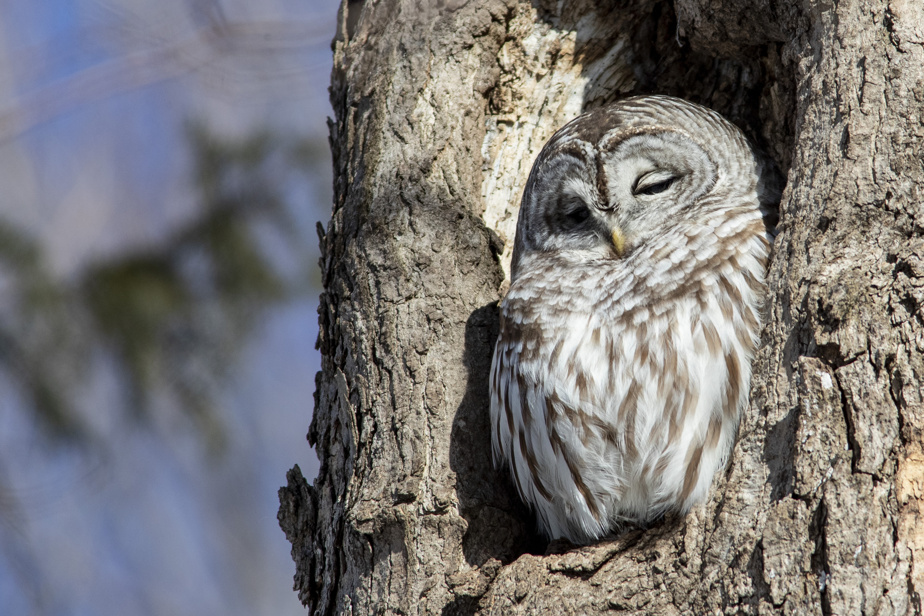Being on top of a mountain to watch the April 8 eclipse might seem like a good idea. In fact, outdoor enthusiasts should rather look towards marshy lands or fields.
“It is in open environments, especially marshes, that there is action,” declares Marc-André Villard, biologist at SEPAQ.
Visually speaking, the total eclipse on April 8 should be spectacular. However, the sound aspect could be fascinating in the great outdoors. How will the birds and amphibians react? Will a great silence settle in? Or should we, on the contrary, expect a nasty uproar?
“The only problem is the timing,” says Mr. Villard. The date is not ideal, nor is the time. Relatively few birds will return to the forest and singing activity is generally very reduced by mid-afternoon. »
Hence the idea of turning to open environments, such as fields and marshes. Marc-André Villard explains that in the spring, when everything thaws, spring peepers are the first to appear. However, this year, spring is rather early.
“In high season, when everything is thawed and all the tree frogs in a marsh are making a racket, it’s spectacular,” he says. It is then easy to see if the tree frog song stops. »
Patrick Paré, biologist and director of the Conservation and Research team at the Granby Zoo, notes that the wood frog is also active at the beginning of April.
“Who knows, in the middle of the afternoon, she might start singing more with the darkness,” he says. That would have to be checked. »

PHOTO MARTIN CHAMBERLAND, LA PRESSE ARCHIVES
The red-winged blackbird is back after winter. How will he react to the eclipse?
Some spring birds have begun their return, such as red-winged blackbirds, grackles and buntings, which favor fields and marshes, says Marc-André Villard. That’s good, they are particularly vocal birds. The long shrill cry of the blackbird is always one of the first signs of spring. It remains to be seen how he will react to the sudden darkness.
Many birds that prefer wooded areas, such as thrushes and warblers, have not yet returned.
On the other hand, you can listen for nocturnal birds, such as the barred owl or the eagle owl. Will they start hooting as darkness sets in?
The fact remains that to clearly see all the stages of the eclipse, you must be in a clear location. Which is far from guaranteed in Quebec’s nature, with its very thick forests. Although the deciduous trees will still be bare in early April, there will be enough branches to obstruct the view.

PHOTO PHILIPPE BOIVIN, LA PRESSE ARCHIVES
It’s tempting to visit a peak to view the April 8 eclipse.
We can look for a bare summit, but there are not that many of them in the Quebec regions that will be crossed by the eclipse, namely Montérégie, the Eastern Townships and Chaudière-Appalaches. We can expect them to be stormed. Hereford Forest, for example, organized a special eclipse-viewing hike to the summit of Mount Hereford, located right in the middle of the eclipse’s path. This special activity has been full for several weeks already. This is also the case for hikes at the Bromont Summits Park.
It will also be impossible to visit the Mont-Mégantic national park if you have not already obtained one of the precious passes which have flown like hotcakes.
Also take into consideration that the mud season will probably start in early April.
The trails are particularly vulnerable during the thaw period and to avoid excessive damage, many managers close access to the trails.
You will therefore need to consult the websites and Facebook pages of the various trail managers. And book quickly if the site requires access.
The Adirondack Mountains in upstate New York will also be right in the path of the eclipse. There are many bare peaks, but the Adirondack trails are known to be particularly muddy during this season. The Lake Placid tourist site strongly advises against hiking to high peaks to observe the eclipse.
“Spring weather can involve snow, ice, and even a combination of all three,” one writes.
Parking lots at the start of the trails, already insufficient in normal times, risk overflowing.
Experienced paddlers may want to position themselves in the center of a body of water. Caution is advised: at this time of year, the water is freezing. You should definitely not fall backwards…
Video suggestion
Whiteness
A little more skiing before the cycling season. Here, the giants of Alaska.
Watch the full video
Number of the week
115
This is the number of warbler species in the world. There are 29 nesting in Quebec.
